Lower Valdarno - Works of Hydraulic and Military Engineering
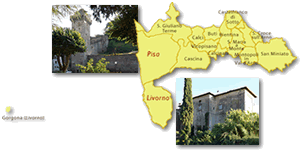
The Lower Valdarno is a territory whose economy for centuries has been tied to water. The use of the River Arno as a privileged communication route and fishing in the Fucecchio swamp constituted sources of supply and wealth for the centres that populated this territory since the Middle Ages. The progressive works of reclamation that in part modified the landscape of the valley, also had consequences on man’s relation with the surrounding environment, giving life to an intense agricultural exploitation which, still today, characterises this part of Tuscany.
The itinerary can begin in the vicinity of Vicopisano whose imposing defensive structures, on which Brunelleschi himself probably worked, are alone enough to justify a visit to this fascinating village.
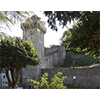
Conquered by the Florentines in 1406, the Castle of Vicopisano represented an important strategic-military point, being situated near the course of the Arno which, up to the middle of the 16th century, that is, up to the hydraulic works ordered by Cosimo I and Francesco I de' Medici, passed between Calcinaia and Bientina. The castle was thus situated on the boundary line between Pisa and Lucca, and as such, of decisive importance for the control of river trade. For this reason the Republic of Pisa had been especially attentive, since the 13th century, to the defensive system of the town, which, in fact, resisted numerous attacks from Lucca. It was only in 1406 that the Florentines, after 8 months of siege, managed to overcome Pisan resistance, thanks also the support, it is said, of ships that bombarded Vicopisano from the Arno. But the conquerors did not leave the town to decline, but provided instead for fortifying it still further, using as consultant one of the greatest architects of the time, Filippo Brunelleschi, renowned also as military engineer. The technical model elaborated by Brunelleschi in 1435 did not differ from the military models of the time, based substantially on elements of medieval military technology. However, the geometric perfection of the layout and the play of proportions among the individual parts brought the role of geometry into the foreground - the great theme of art-science of Brunelleschi and of fifteenth-century humanist culture - as a "weapon" of defence.
The Rocca consisted of a donjon standing at the highest point of the town, from which ran a wall connecting it to the Selvatici Tower. The whole was surrounded by an imposing circle of walls with a walkway all around the top and with square and semicircular towers along it. Lost and then conquered again by Florence, the Rocca was first abandoned and then bought by private individuals. After recent restoration, the defence system that surrounds the picturesque town is today fully available as a tourist-cultural attraction.
(Elena Fani)
The economy of the town was for centuries tied to the nearby Lake Bientina, formerly the largest lake in Tuscany. Among the structures realised to reclaim this body of water, one of the most interesting is without a doubt Manetti’s "Barrel", which can be reached via SP1.
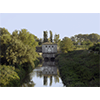
In 1852, Grand Duke Leopold II of Lorraine approved Alessandro Manetti’s project to drain Lake Bientina, which provided for diverting the Imperial Canal built slight more than a century before on a project by Leonardo Ximenes. The diverted emissary was to pass under the bed of the River Arno by means of a so-called "barrel", that is to say an underground conduit measuring 255 metres in length.
The first stone of this extraordinary work of hydraulic engineering was laid on September 16, 1854. The Grand Duke was so struck by the impressiveness of the work, which ended in 1859, that he described the various construction phases in his Governo di Famiglia . The daring structure can still be admired today.
(Graziano Magrini)
Between Bientina and Altopascio, the visitor can see the remains of the old body of water than since the mid 18th century was targeted with systematic interventions. The most significant token of this phase of work consists in Ximenes’ Floodgates, built in 1757 in the locality of Riparotto on the outskirts of Vicopisano, near SP2.
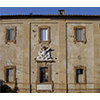
The two edifices of five floodgates were built on a project by Leonardo Ximenes, on the occasion of his reclamation of Lake Bientina, begun in 1757. The purpose of the floodgates was to regulate the flow into the Arno of the waters of Lake Bientina by means of the Serezza Vecchia canal and, in particular, of the Imperial Canal, opened by Ximenes himself. In order to permit the continuous navigation of the Imperial Canal, two "supports" or sluices were also planned, which enabled boats to pass near the floodgates. Today, the two canals have been interred, and the buildings could do with restoration.
(Graziano Magrini)
Following SP2, we come to an even older monument tied to hydraulic engineering, the Medici Aqueduct of Asciano, built in the 17th century by order of the Grand Dukes of Tuscany.
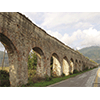
The project for an aqueduct capable of supplying the city of Pisa with the benevolent water of the Pisan Mountains was ordered by Cosimo I de’ Medici. Credit must go to Grand Duke Ferdinando I, however, for the construction of the long aqueduct that from Bottino di San Rocco in the Fonti valley reaches the walls of Pisa.
Begun in 1592 on a design by architect Raffaello di Zanobi di Pagno, who was succeeded by Andrea Sandrini from Siena, it had more than 900 arches and wound along a course of 6 kilometres. In the 1597 treatise, Dei Bagni di Pisa, famous physician Girolamo Mercuriale considered the aqueduct of Asciano to be among «the almost divine works of Ferdinando I». The Lorraine engraver Jacques Callot depicted the Visita di Ferdinando I ad Asciano in an engraving done in the second decade of the 17th century, documenting the Grand Duke’s direct interest in the works.
Today, the aqueduct stands out in the countryside between Asciano and Pisa, and along many tracts has a picturesque route for walks and cycling.
(Alessandro Tosi)
Finally, also tied to the water culture that developed in the Lower Valdarno, located 6 km away on the Abetone SS12, is San Giuliano Terme which since the Middle Ages has been one of the best-known and frequented sources of curative waters in Tuscany.
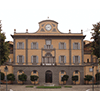
The baths of San Giuliano, known already to the Etruscans and the Romans, were rebuilt during the course of the Middle Ages. In the early 15th century, Ugolino da Montecatini recommended these waters for the treatment of various disorders. After a period of decline, the baths were rebuilt in the 18th century, under the government of the Regent, Francis Stephen of Lorraine, and soon became one of the most important thermal centres in the Grand Duchy and a fashionable place frequented by prominent Tuscan and foreign families.
The eighteenth-century revival of thermal centres was accompanied by a number of scientific studies on mineral waters. One of the most significant of these concerned the waters of San Giuliano. In 1750, in fact, the physician Antonio Cocchi published in Florence a treatise (Dei Bagni di Pisa) in which the waters were analysed from the chemical viewpoint and in relation to their therapeutic properties. As recorded by a memorial stone from 1908 found at the baths, the scientist Giuseppe Orosi, director of the Pisa School of Pharmacy from 1865-66 to 1875-76, began here to conduct the first chemical research. During the 19th century the baths of San Giuliano – along with those of Montecatini and Bagni di Lucca – developed still further, both as therapeutic centres and as resort towns, becoming favourite places to stop in the refined, cultured grand tour of the 19th century.
Today the thermal baths, which over the course of time have welcomed illustrious guests, scientists, authors and artists, continue to be a place of relaxation and wellness.
(Graziano Magrini)
****************************
Texts by Elena Fani
English translation by Victor Beard
Last update 26/gen/2008



 = libraries and archives
= libraries and archives  = scientific research centers
= scientific research centers  = memorial places of scientists
= memorial places of scientists = public health places
= public health places = places of science and worship
= places of science and worship = places of technology
= places of technology  = museums and collections
= museums and collections  = villas and gardens of science
= villas and gardens of science

